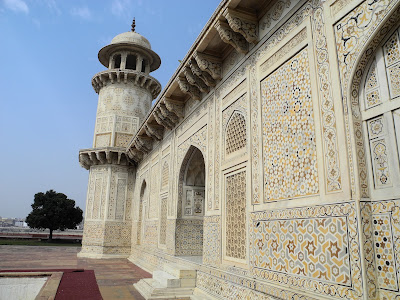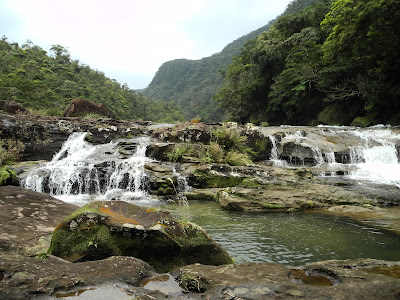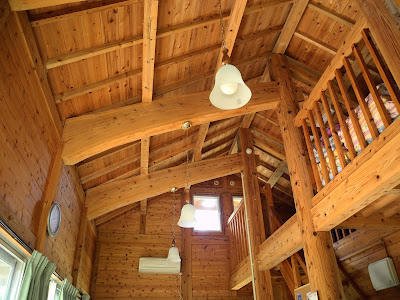I wrote recently about the delicate geometric carved marble screens of Mughal (Muslim) architecture in India. The painstaking craftsmanship of the marble screens is matched by the pietra dura marble inlay found in Indian Mughal architecture, one of the best and most famous examples of which is the Taj Mahal. If pietra dura sounds Italian, that's because it is. The technique came to India in the early 17th century, by which time smaller marble inlay objects from Italy were widely distributed through trade. Those that came to India were imitated and the technique was later adapted to local designs and purposes. In English the technique is known by the Italian name, but in Mughal India it was called parchin kari, which translates literally as simply inlay work.
It differs from mosaic work in that each marble piece is cut to fit the design, rather than cutting a number of modular pieces and assembling an image from these repeated shapes. So if the design is a rose, a rose is cut of coloured marble, with highlights, stem and leaves cut from other colours, and a rose-shaped recess is cut into the wall of a building, so the two can be fitted together.
The main building of the Taj Mahal was completed in an astonishing 8 years, through the efforts of 20,000 craftsmen (and 1,000 elephants). In another 12 years the outlying buildings were also complete. On one side of the tomb, which has perfect symmetry on all four sides, is a mosque, facing west toward Mecca as all mosques do. In the interest of symmetry, another building identical to the mosque, complete with identical pietra dura inlay and marble carving, was built on the opposite side of the tomb. This building has no function, except to complete the desired symmetry.
In the 20th century air pollution had dirtied the facade of the Taj to such an extent that when President Clinton visited in the year 2000 and commented on the sorry state of what is widely considered the most beautiful building in the world, the city of Agra moved all its industry 100km away from the monument, permanently banned polluting vehicles like cars and rickshaws within 1km, and gave the Taj a "facelift", covering the whole building with a traditional Indian women's face-whitening recipe!
The interior of the Taj Mahal is home to even more technically challenging work: rounded archways are inlaid with floral motifs that wrap around the two curves of the arch itself and the rounded marble outlining the arch (photography prohibited). All of these pieces, and the recesses they fit into, have been cut along curves in two directions to achieve a perfect fit.
The Tomb of Itmad-Ud-Daulah, also known as the Baby Taj for its resemblance to the form of the Taj Mahal, is sometimes also called by a third name, the Jewel Box, because of its elaborate pietra dura decoration. This monument was the first example of Mughal architecture to make extensive use of pietra dura. The tomb is almost entirely covered in inlay, even on the round towers of its minarets.
Like other Mughal decorative arts, the pietra dura as it is used in India is mainly geometric, floral or calligraphic in its patterns, due to the Islamic prohibition against depicting human or anthropomorphic subjects in art.
Continuing our around-the-world trip, we visited Italy a few weeks after India, and I was delighted to see the pietra dura floors of the Duomo (cathedral) in Florence. As our travels took us from parchin kari in India to pietra dura in its original home in Italy, from Mughal architecture in India to Moorish architecture in Spain, it seemed we were retracing history.
detail of pietra dura marble inlay at Akbar's Tomb, in Agra
It differs from mosaic work in that each marble piece is cut to fit the design, rather than cutting a number of modular pieces and assembling an image from these repeated shapes. So if the design is a rose, a rose is cut of coloured marble, with highlights, stem and leaves cut from other colours, and a rose-shaped recess is cut into the wall of a building, so the two can be fitted together.
Pietra dura at Akbar's Tomb, in Agra
In the 20th century air pollution had dirtied the facade of the Taj to such an extent that when President Clinton visited in the year 2000 and commented on the sorry state of what is widely considered the most beautiful building in the world, the city of Agra moved all its industry 100km away from the monument, permanently banned polluting vehicles like cars and rickshaws within 1km, and gave the Taj a "facelift", covering the whole building with a traditional Indian women's face-whitening recipe!
The entire Taj Mahal is a tomb, built by Emperor Shah Jahan for his wife Mumtaz Mahal, who died giving birth to their 14th child. Shah Jahan was also interred in the Taj Mahal following his death eight years after the completion of the monument. Overthrown and imprisoned by his power-hungry son Aurangzeb soon after the tomb's completion, he spent the last eight years of his life jailed in nearby Agra Fort, with only a distant view of the masterpiece from the window of his cell.
The exterior of the main building is covered in prayers, written in Islamic calligraphy inlaid into the white marble.
The interior of the Taj Mahal is home to even more technically challenging work: rounded archways are inlaid with floral motifs that wrap around the two curves of the arch itself and the rounded marble outlining the arch (photography prohibited). All of these pieces, and the recesses they fit into, have been cut along curves in two directions to achieve a perfect fit.
The Tomb of Itmad-Ud-Daulah (aka Baby Taj), Agra
Like other Mughal decorative arts, the pietra dura as it is used in India is mainly geometric, floral or calligraphic in its patterns, due to the Islamic prohibition against depicting human or anthropomorphic subjects in art.
Continuing our around-the-world trip, we visited Italy a few weeks after India, and I was delighted to see the pietra dura floors of the Duomo (cathedral) in Florence. As our travels took us from parchin kari in India to pietra dura in its original home in Italy, from Mughal architecture in India to Moorish architecture in Spain, it seemed we were retracing history.
pietra dura floors of the Duomo, Florence








.jpg)






















